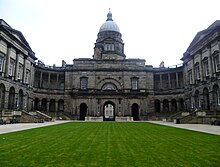Scottish education in the eighteenth century
By the late seventeenth century there was a largely complete network of parish schools in the Lowlands, but in the Highlands basic education was still lacking in many areas.Until the late eighteenth century most schools buildings were indistinguishable from houses, but the wealth from the Agricultural Revolution led to a programme of extensive rebuilding.Many burgh schools moved away from this model of teaching from the late eighteenth century as the new commercial and vocational subjects led to the employment of more teachers.[1] Historians now accept that very few boys were able to pursue this route to social advancement and that literacy was not noticeably higher than in comparable nations, as the education in the parish schools was basic and short and attendance was not compulsory.[3] By the eighteenth century many poorer girls were being taught in dame schools, informally set up by a widow or spinster to teach reading, sewing and cooking.[5] Among members of the aristocracy by the early eighteenth century a girl's education was expected to include basic literacy and numeracy, needlework, cookery and household management, while polite accomplishments and piety were also emphasised.[12] The five ancient Scottish university colleges recovered from the disruption of the Reformation, civil wars and Restoration with a lecture-based curriculum that was able to embrace economics and science, offering a high-quality liberal education to the sons of the nobility and gentry.[1] In the eighteenth century Scotland's universities went from being small and parochial institutions, largely for the training of clergy and lawyers, to major intellectual centres at the forefront of Scottish identity and life, seen as fundamental to democratic principles and the opportunity for social advancement for the talented.Much of what is incorporated in the scientific method (the nature of knowledge, evidence, experience, and causation) and some modern attitudes towards the relationship between science and religion were developed by his protégés David Hume (1711–76) and Adam Smith (1723–90).He and other Scottish Enlightenment thinkers developed what he called a 'science of man',[22] which was expressed historically in works by authors including James Burnett, Adam Ferguson, John Millar and William Robertson, all of whom merged a scientific study of how humans behave in ancient and primitive cultures with a strong awareness of the determining forces of modernity.




Haddingtonparish schoolsAgricultural Revolutiondame schoolsEuropean EnlightenmentEducation in early modern ScotlandKingsford, East AyrshireLowlandsHighlandsRobert Gordon's HospitalWilliam AdamLady Grisell BaillieMaria Verelstpolite accomplishmentsLady Elizabeth WardlawLady Grizel BaillieScottish GaelicSociety in Scotland for Propagating Christian KnowledgeJacobitismEnlightenment in ScotlandOld College, University of EdinburghRobert AdamobservatoriesRobert SibbaldRoyal College of Physicians of Edinburghmedical schoolLeidenUnited College of St Salvator and St LeonardBelles LettresFrancis HutchesonUniversity of GlasgowThomas Hobbesutilitarianconsequentialistscientific methodsciencereligionDavid HumeAdam SmithHugh BlairShakespeareOssianJames Macphersonsceptical philosophicalempiricistscience of manJames BurnettAdam FergusonJohn MillarWilliam RobertsonmodernityThe Wealth of Nationseconomic policyglobalisationtariffsWilliam CullenJames AndersonagronomistJoseph BlackphysicistJames HuttongeologistA. HermanHow the Scots Invented the Modern WorldEducation in ScotlandOverviewUniversitiesMedievalEarly modernNineteenth centuryTwentieth centurySchoolsEducation ScotlandHer Majesty's Inspectorate of EducationLearning and Teaching ScotlandGeneral Teaching Council for ScotlandScottish Children's Reporter AdministrationScottish Funding CouncilScottish Qualifications AuthorityStudent Awards Agency for ScotlandUniversities ScotlandGaelicArt collegesFurther education collegesGaelic-medium schoolsPrivate (independent) schoolsState schoolsEnglandNorthern Ireland